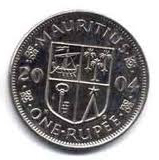|


The rupee (ISO 4217 code: MUR) is the currency of Mauritius. It is divided into 100 cents.
History
The rupee was established by law in 1876 as the local currency of Mauritius. The rupee was chosen due to the massive inflow of Indian rupees following Indian immigration to Mauritius. The Mauritian rupee was introduced in 1877, replacing the Indian rupee, sterling and the Mauritian dollar, with the Mauritian rupee equal to one Indian rupee or half a Mauritian dollar. The pound was worth 10¼ rupees at that time. The Mauritian currency also circulated in the Seychelles until 1914, when it was replaced by the Seychellois rupee at par.
In 1934, a peg to sterling replaced the peg to the Indian rupee, at the rate of 1 rupee = 1 shilling 6 pence (the rate at which the Indian rupee was also pegged). This rate, equivalent to 13⅓ rupees = 1 pound, was maintained until 1979.
Coins
In 1877, coins for 1, 2, 5, 10 and 20 cents were introduced, with the lower three denominations in copper and the higher two in silver. Coin production ceased in 1899 and did not recommence until 1911, with silver coins not produced again until 1934, when 1/4, 1/2 and 1 rupee coins were introduced. In 1947, cupro-nickel 10 cents were introduced, with cupro-nickel replacing silver in 1950.
In 1987, a new series of coins was introduced which, for the first time, did not feature the portrait of the monarch (Mauritius did not become a republic until 1992) but that of Sir Seewoosagur Ramgoolam. This coinage consisted of copper-plated-steel 1 and 5 cents (the 5 cents was substantially reduced in size), nickel-plated-steel 20 cents and ½ rupee, and cupro-nickel 1 and 5 rupees. Cupro-nickel 10 rupees were introduced in 1997. Coins currently in circulation are the 1, 5 and 10 rupees.
In 2007, a bi-metallic 20-rupee coin was issued to commemorate the 40th anniversary of the Bank of Mauritius.
Banknotes
The first banknotes were issued by the government dated 1876 in denominations of 5, 10 and 50 rupees. 1 rupee notes were added in 1919. In 1940, emergency issues were made of 25 and 50 cents and 1 rupee. In 1954, 25 and 1000 rupees were introduced .
As from 1966, Bank of Mauritius has been responsible for the issue of banknotes and coins. The Bank of Mauritius issued its first notes in 1967, comprising 4 denominations: 5, 10, 25 and 50 rupees. This set of banknotes went through four issues whose only variations which varied only in the signatures of the Governors and the Managing Directors of the Bank of Mauritius appointed during that period.
The Bank of Mauritius made its fifth issue 1985, which consisted of a complete new set of banknotes of 5, 10, 20, 50, 100, 200, 500 and 1000 rupees. A close study of these banknotes reveals an interesting array of subsets which were printed by two banknote printing companies. The notes were also designed at different time periods as there are very few identical and consistent design features appearing on all the denominations. Varying banknote numbering systems, different types of security threads, variations in the design and size of the Mauritian Coat of Arms, different ultraviolet light latent printing, inconsistent variations in the size incrementation between the denominations and multiple different typesets are just a few of the differences. This issue lasted up to 1998.
In 1998, The Bank of Mauritius made a sixth issue of banknotes consisting of 7 denominations, viz. 25, 50, 100, 200, 500, 1,000 and 2,000 rupees. These banknotes had a standard format and were all issued simultaneously in November 1998. All the banknotes of this issue were printed in England by “Thomas de la Rue Limited”. These banknotes were withdrawn from circulation in June 1999 following controversies.
The Bank of Mauritius made its seventh issue of banknotes, which is still current, after June 1999.
Currently circulating banknotes
Obverse designs
There is also a drawing of the Bank of Mauritius building and a portrayal of the statue of justice on each of the denominations. Below the denomination in the top right hand corner is a feature to aid the visually impaired. This is in addition to the differences in sizes between the banknotes of various denominations.
Reverse Designs
Each denomination carries a different vignette, depicting various aspects of Mauritius. The value figure in Tamil and Hindi can be found below the vignette.
Features for authenticity verification
1. The feel of banknotes paper
2. Three-dimensional watermark in the form of a dodo: when held up to the light the head of the dodo can be clearly viewed.
3. See-through in the form of a conch shell: this image completes when viewed against direct light.
4. Windowed security thread reading “Bank of Mauritius” when held up to the light, this can be seen as a continuous band running through the paper. Viewed flat, the metallic areas can be seen on the surface of the paper.
5. Engraved Portrait in Intaglio ink.
6. Latent image: when viewed at eye level, the image of “BM” becomes visible.
7. Micro-text reading “BM”: under a magnifying glass these letters are clear to see.
8. Under ultra-violet light: figures corresponding to the face value of the banknote become apparent.
Iridescent band in gold: when held under the light, this band visualizes and disappears when the viewing angle is changed.
100, 200 rupee notes
Silver metallic ink: dull silver metallic band running from top to bottom on front, left of note. Metallic strip also beneath top right value numeral.
500, 1000 rupee notes
Silver Foil: two different images, value numeral or geometric shape, can be seen when viewed from different angles.
2000 rupee note
Hologram containing images of the dodo and the value “2000”
The text on this page has been made available under the Creative Commons Attribution-ShareAlike License and Creative Commons Licenses
| 